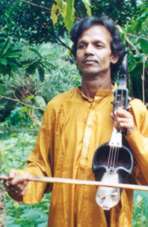
Since the sarangi was associated with courtesans and nautch girls, it was unwelcome in religious company. It is believed that the fifth Guru of the Sikhs, Guru Arjan, had a new instrument created, similar to the sarangi but also different, which could be used to accompany hymns. This was the sarinda. Some scholars trace the sarinda back to the region around Kabul and still others believe that the instrument was common in Bengal and Assam where it was used to accompany hymns. The Assami sarinda is called the cherengdar. A desert tribe of Rajasthan is also known for its sarinda-playing. This quaint-looking bowed instrument is made entirely of wood. The bowl is oval and bridged by a strip of wood. The wires resting on it are positioned like the wires of the sarangi. The fingers are pressed on the wires to form notes. The instrument is austere with no embellishments, save the delicate paintwork. Today this instrument is extremely rare.
Source: http://www.punjabilok.com/music/sarinda.htm
Other instruments such as the Sarinda and Sarangi relate more to the Indian world. The former is popular in the eastern and southern provinces of Afghanistan among Pashtuns. In the case of both the Sarinda and the Sarangi the strings are not pressed against the fingerboard while playing, as with the Western violin, but resonate freely.
Source:http://www.radioafghanistan.com/introduction/intro1.htm